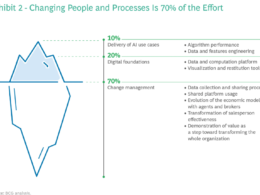Harvard Business Review
by Katherine C. Kellogg
February 13, 2019
Organizational change is difficult, no question about it.
It’s challenging to get people who are set in their ways to go about their jobs differently.
So what types of interventions might actually change people’s behaviors in ways that make change more palatable?
To answer that question, I conducted a two-year ethnographic study of the primary-care departments in two U.S. hospitals.
The hospitals were part of the same parent organization, did similar work, and employed doctors and clinical staff with similar backgrounds.
In addition, both hospitals had received grants of $750,000 to implement a change within their organizations: patient-centered medical home (PCMH) reforms that are being rolled out across the United States.
PCMH requires primary-care doctors to change their daily work practices by moving from reactive care to prevention (vaccinations, pap smears, mammograms, colonoscopies, and so on) and by using evidence-based guidelines to treat patients with chronic illnesses like diabetes.
I observed the day-to-day work at both hospitals for three months before the start of their PCMH initiatives.
Specifically, I studied the interactions between managers, doctors, and medical assistants, since they were the key players involved in the day-to-day changes in line with the reforms.
I observed them as they engaged in activities such as “huddling,” where doctors and medical assistants discussed the conditions and progress of patients coming in for office visits that day, and strategic planning meetings, in which managers, doctors, and medical assistants talked about how to best implement the reforms.
After the PCMH reforms were introduced, I continued observing those interactions for the next two years.
In total, I shadowed and interviewed 48 doctors, 10 managers, and 24 medical assistants.
I also analyzed documents, including PowerPoint presentations, clinic paperwork, and other materials that the managers developed to facilitate the implementation of PCMH.
Initially, a small number of doctors were adamantly opposed to the PCMH reforms, while the majority believed the changes had merit.
Even for those who had a positive view of PCMH, however, many felt the reforms might run counter to their ability to apply their specialized expertise to help the ill, and to use their discretion and autonomy to treat patients.
In other words, while widespread pushback wasn’t common, some degree of resistance was.
In the end, managers at one hospital were much more successful in changing their doctor’s behavioral practices than were managers at the other hospital.
Specifically, across three phases of the study, the adoption rate for PCMH practices at the successful hospital soared from 6% to 65%, while the rate at the other hospital remained relatively flat from the initial low 6%.
Specifically, across three phases of the study, the adoption rate for PCMH practices at the successful hospital soared from 6% to 65%,
while the rate at the other hospital remained relatively flat from the initial low 6%.
Why the huge difference?

From an analysis of the data, I was able to identify the most significant factor:
On the teams that were most successful, managers had enlisted the aid of medical assistants to help change the doctors’ behaviors.
At both facilities, the medical assistants were responsible for bringing patients from the waiting area to the exam room, weighing them, and taking their blood pressure.
And yet despite having no formal authority over doctors, the medical assistants had a high capacity for influence because they had a lot of structural power.
First, the medical assistants occupied a central position in the doctors’ workflow.
They could both remind doctors to implement new practices such as delivering particular vaccinations, and could give doctors opportunities to review and approve suggested changes before they were implemented.
Second, they performed tasks that were critical to doctors’ daily work, making it relatively easier for them to ask the doctors for favors; …
… this led doctors to see themselves as implementing the new practices to help their medical assistants rather than to meet managerial demands.
Third, the medical assistants were central in the doctors’ peer network, enabling them to spread the word about those doctors who had adopted the new practices.
And fourth, they were positioned between the patients and the doctors, so they could suggest changes in doctors’ practices while also shielding doctors from the emotional challenges of upset or angry patients.
But it wasn’t just that the medical assistants had a lot of structural power; they were given specific tools to leverage this structural power to persuade the doctors to implement PCMH.
Specifically, the managers at the successful hospital provided the medical assistants with things like visual prompts, which helped indicate whether a particular patient was due for a certain procedure or test.
For example, each patient packet included a purple checkout form, in which the medical assistants could mark any required colonoscopies or mammograms as a helpful reminder to the doctors.
“The purple sheet is helpful,” said one doctor. “There is so much going on [at the time of the visit] that it’s good to be reminded.”
Another effective tool was “favor scripts” provided to the medical assistants.
One script was to help persuade doctors to implement a particular reform for treating diabetes.
In the script, medical assistants would pose the change as something a doctor could do as a favor to them (“It’s very helpful for me if you would…”) as opposed to being a policy imposed by management (“We need to do this…”).
As one medical assistant recalled, “I told [doctor] that when patients are on the list, I need to keep managing them, and that takes time.
Finally, she said she would do the [lipid panel checks] to get those patients off the list for me.”
In other words, the doctors viewed themselves as helping the medical assistants and, as one doctor noted, “We want to keep the MAs happy because we depend on them.”
Doctors were willing to make changes to help their MAs, as long as these decisions did not run counter to their clinical judgment.
In other words, the doctors viewed themselves as helping the medical assistants and, as one doctor noted, “We want to keep the MAs happy because we depend on them.”
Doctors were willing to make changes to help their MAs, as long as these decisions did not run counter to their clinical judgment.
These tools were effective because they significantly lessened the degree to which the reforms threatened the doctors’ expertise, autonomy, individual responsibility for patients, and engagement in complex work.
Importantly, the managers at the successful hospital freed up time for their MAs to engage in the new work associated with influencing the doctors.
They also established a two-way dialogue that allowed MAs to tell the managers about the hurdles they were facing and to ask for the resources they needed to address them.
For example, it was the traditional practice in both hospitals to cover staffing shortfalls by rotating MAs who had few doctors in session on a particular day from one area of the department to another.
With the introduction of PCMH, MAs needed to do offline work to identify which patients were due for vaccinations, pap smears, and the like.
When managers rotated MAs, MAs experienced work intensification because they could not use downtime to catch up on this offline work.
The MAs discussed amongst themselves and raised this issue with their managers. The managers responded by eliminating rotation of the MAs.

While the MAs at the successful hospital reported that the quality of their work life had improved from using these tactics, they do raise possibility of manager exploitation of semiprofessionals, if used without attention to semi-professionals’ well-being.
Future research could explore the costs for semi-professionals that stem from engaging in influence attempts with more powerful professionals on behalf of managers, and how these might be prevented.
While my study investigated two hospitals that were trying to change the work practices of its doctors, I believe the idea of leveraging the structural power of low level workers to push change from the bottom up has broader implications, especially for other organizations employing professionals.
This might include law, accounting, or consulting firms, among others. For example, could a law firm more effectively alter the behavior of its lawyers by enlisting the aid of its paralegals in the change initiative?
I believe the idea of leveraging the structural power of low level workers to push change from the bottom up has broader implications, especially for other organizations employing professionals.
And might companies do the same with their administrative assistants when implementing organizational change?
Given the dismal success rate of change initiatives at many companies, enlisting low-level semi-professionals to help change the practices of the professionals with whom they work is certainly an approach worth considering.
Originally published at https://hbr.org on February 13, 2019.











